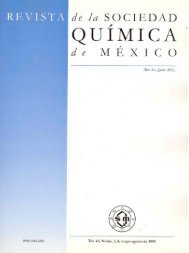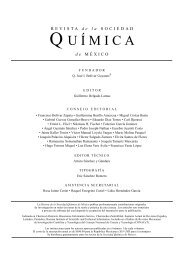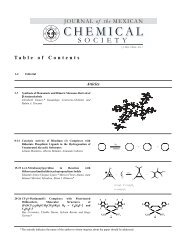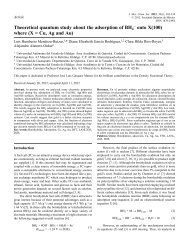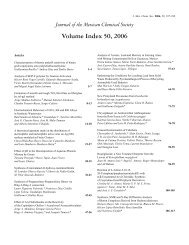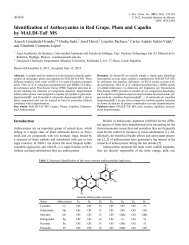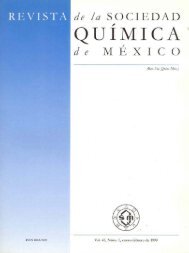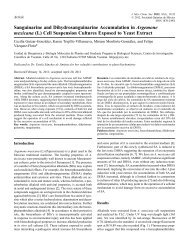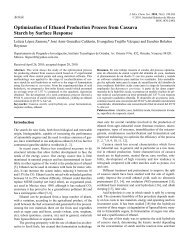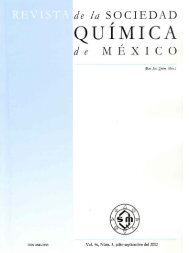Pincer Complexes. Applications in Catalysis
Pincer Complexes. Applications in Catalysis
Pincer Complexes. Applications in Catalysis
You also want an ePaper? Increase the reach of your titles
YUMPU automatically turns print PDFs into web optimized ePapers that Google loves.
340 Rev. Soc. Quím. Méx. 2004, 48 David Morales-Morales<br />
These complexes have demonstrated analogous reactivities<br />
and stabilities as their phosph<strong>in</strong>ated counterparts.<br />
However, an <strong>in</strong>terest<strong>in</strong>g characteristic of the SCS p<strong>in</strong>cer ligands<br />
is the facile functionalization of the aromatic backbone<br />
to attach tails that <strong>in</strong> turn can be l<strong>in</strong>ked to polyethylene glycol<br />
supports (8), thus generat<strong>in</strong>g highly stable and highly active<br />
catalyst that can be easily separated, isolated and then used<br />
aga<strong>in</strong> for at least three cycles without decrease <strong>in</strong> activity [10].<br />
Thus, characteristics like the supreme activity and superior<br />
thermal stability that the palladium p<strong>in</strong>cer complexes have<br />
shown <strong>in</strong> the C-C coupl<strong>in</strong>g reactions (Heck type reactions),<br />
has lead to Jensen and Morales-Morales [7] to propose an<br />
alternative reaction mechanism <strong>in</strong>volv<strong>in</strong>g Pd(II)/Pd(IV) [5,7]<br />
species <strong>in</strong>stead of the traditionally accepted mechanism<br />
<strong>in</strong>volv<strong>in</strong>g Pd(0)/Pd(II) species. This reaction mechanism is<br />
still under debate.<br />
Suzuki-Miyaura Coupl<strong>in</strong>gs<br />
The Suzuki or Suzuki-Miyaura C-C coupl<strong>in</strong>gs [11] consist <strong>in</strong><br />
the reaction of a halobenzene with arylboronic acids <strong>in</strong> the<br />
presence of a base. This reaction proceeds by a similar reaction<br />
mechanism as that of the Heck reaction, thus most of the<br />
catalysts usually employed <strong>in</strong> the Heck coupl<strong>in</strong>g reactions<br />
have been successfully employed <strong>in</strong> the Suzuki reaction too.<br />
Thus, Pd(II) complexes hav<strong>in</strong>g phosph<strong>in</strong>ito PCP p<strong>in</strong>cer<br />
ligands (9) have been successfully used by Bedford et. al [12]<br />
<strong>in</strong> the coupl<strong>in</strong>gs of aryl halides with phenyl boronic acid,<br />
exhibit<strong>in</strong>g quantitative yields and turnover numbers <strong>in</strong> the<br />
order of 92,000. These complexes are also efficient <strong>in</strong> the coupl<strong>in</strong>gs<br />
of deactivated and sterically h<strong>in</strong>dered aryl bromides.<br />
On the other hand, Pd(II) SCS p<strong>in</strong>cer complexes (10)<br />
have also been employed <strong>in</strong> the Suzuki type coupl<strong>in</strong>gs, however<br />
their application has been limited be<strong>in</strong>g only active <strong>in</strong> the<br />
reaction of p-bromotoluene with phenyl boronic acid to a<br />
maximum of 69% yield of the correspond<strong>in</strong>g biphenyl [13].<br />
Dehydrogenation of alkanes<br />
Saturated hydrocarbons represent one of the most abundant<br />
and accessible feedstocks <strong>in</strong> our planet [14]. However, their<br />
use has been limited due to the <strong>in</strong>tr<strong>in</strong>sic lack of reactivity of<br />
these compounds [15]. An <strong>in</strong>terest<strong>in</strong>g alternative to this problem<br />
has been the use of transition metal complexes able to<br />
activate C-H bonds under mild reaction conditions [16]. Some




